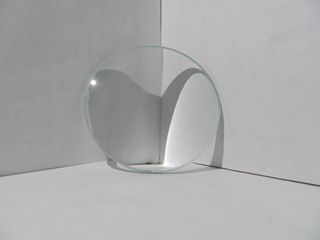The first thing you should be aware of, is the difference between temperature and heat. Heat is thermal energy (energy related to the mean speed of the molecules/atoms in your material) that a body has, and is useful because energy is conserved. So if you have heat transfer from a body to another, if you know that the first body gives the second 10 Joules, the second receives the same amount. Temperature is related to the amount of heat a body has, but it is not conserved, because different materials have different heat capacities. This means that different materials will have different temperatures when they have the same thermal energy.
In your solar heater, the receiver gets heat from the sun ($Q_\mathrm{sun}$), and loses heat to the atmosphere ($Q_\mathrm{atm}$). The steady state will be achieved when the energy flux to the body is equal to the energy flux from the body. That is, when $Q_\mathrm{sun} = Q_\mathrm{atm}$. Note that the units of $Q$ are Energy/time (e.g., Watts)
From the parameters you give, the power the receiver gets is $Q_\mathrm{sun}=P_\mathrm{sun}\,x\,r\,a$, that is, the power density of solar radiation at sea level (about 1.0 kW/m${}^2$) times the area of your dish times its reflectivity times the fraction of that that your receiver absorbs. Notice that this is (essentially) independent of the temperature of the receiver. I believe $a$ might depend a little on that, but not very much.
On the other hand, the heat your receiver loses is not so easy to calculate. It will lose heat by three different processes: radiation, conduction and convection. I think (though I'm not very familiar with this) that convection will be the most important process, but this requires that your receiver is thermally isolated form the rest of the structure of your solar condenser.
So lets say that $Q_\mathrm{atm} = Q_\mathrm{convection}$. If we use Newton's law of convection (not always valid, but a reasonable approximation here, I think) we have $Q_\mathrm{convection}= h\,S(T-y)$, where $h$ is the heat transfer coefficient and $S$ is the surface of the receiver. Notice that this does depend on the temperature of the receiver($T$). I'm not sure what your parameter $i$ is, but I think is related to the conduction of heat.
From the above equations, you can solve for $T$:
$$P_\mathrm{sun}\,x\,r\,a = h\,S(T-y)$$
$$T = y + \frac{P_\mathrm{sun}\,x\,r\,a}{h\,S}$$
Regarding the most important factors in the performance, it's clear that the reflectivity is very important, not only in the visible, but in the infrared too, sine a lot of the energy of the sun's power is infrared. A metallic mirror is good for this. The absorption efficiency will be equally important, too. I think tis will be related to the reflectivity of your receiver: you want it as pitch black as possible (again, in the visible and infrared). You might want to paint it with soot, for example. I'm sure there is a lot of literature on the subject, but again, I'm not an expert on this.
John, your method for determining approximate lens focal lengths is a valid one, although since your eye will automatically accommodate to some extent, accuracy will be limited.
The apparent discrepancies follow from the rather obscure convention of labeling lens "Power" in units of Diopters, which are inverse meters.
The power P of an optic is defined as the inverse of the focal length f in meters:
$$ P = \frac{1}{f} $$
Thus a lens of power $-3$ has a focal length of $-1/3$ meter or $-33$ $cm$, not far from the $f= -30$ $cm$ you estimated. Similarly, a power of $-0.25$ Diopters corresponds to $-4$ $m$ or $-400$ $cm$, a very weak negative lens which would scarcely be noticeable when combined with a fairly high powered positive lens (magnifier).

Best Answer
A lens does not have have one specific magnification, it depends on the positioning of the lens. When neglecting aberrations, the workings of a lens can be simplified with the following equation,
$$ \frac{1}{f} = \frac{1}{v} + \frac{1}{b}, $$
where $f$ is the focal length of the lens, $v$ is the distance from the object to the lens and $b$ the distance from the lens to the image of the object. This is demonstrated in the image below, including three principal rays (these only apply for thin lenses).
Here $\text{F}_1$ and $\text{F}_2$ are the two focal points of the lens, with $f_1$ and $f_2$ as their respective focal lengths (these are often equal to each other, which is also assumed in the first equation).
The resulting magnification, $M$, will be equal to the ratio between $h_1$ and $h_2$, which when expressed in terms of $v$ and $b$ looks as follows,
$$ M = \frac{v}{b}. $$
When you have a lens with a given focal length then you have two equations with three unknown. So, when you want to calculate the magnification you would not have a unique solution. However manufactures probably want to add a label to their lenses which a layman can understand. For this they probably will use eyepiece magnification,
$$ M_e = \frac{250\ mm}{f} $$
where the numerator is equal to the least distance of distinct vision, which is roughly 250 mm for a human with normal vision.
However if you do not know the focal length you can use the following equation,
$$ \frac{1}{f} = (n - 1) \left[\frac{1}{R_1} - \frac{1}{R_2} + \frac{(n - 1) d}{n R_1 R_2}\right], $$
where $n$ is the refractive index of the lens material, $d$ the thickness of the lens, $R_1$ and $R_2$ the radius of curvature of the two sides of the lens.